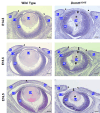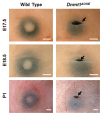DNA methyltransferase 1 regulates epithelial cell functions in corneal and eyelid development
- PMID: 40384767
- PMCID: PMC12085216
DNA methyltransferase 1 regulates epithelial cell functions in corneal and eyelid development
Abstract
Purpose: DNA methyltransferase 1 (DNMT1) is a crucial enzyme for the development of the retina and lens in the eye, but its roles in the cornea and eyelids are yet to be investigated.
Methods: Ocular surface epithelium (OSE)-specific Dnmt1 knockout mice, denoted as Dnmt1ΔOSE , were generated. Prenatal eye tissues were characterized by hematoxylin and eosin staining; DNMT1 expression, DNA methylation, epithelial differentiation and cell-cell junctions were determined by immunohistochemistry; proliferation was assessed by 5-ethynyl 2´-deoxyuridin labeling and apoptosis evaluated by terminal deoxynucleotidyl transferase dUTP nick-end labeling assay. Keratinocytes derived from Dnmt1F/F mice were infected with adenoviruses carrying either green fluorescent protein or Cre recombinase to obtain wild-type and Dnmt1-deficient cells. In these cells, Dnmt1 expression and epithelial terminal differentiation were evaluated by real-time PCR and/or western blotting; adherence junction and apoptosis were assessed by immunohistochemistry; proliferation was determined by 5-ethynyl 2´-deoxyuridin labeling; transcription factor activities were determined by luciferase reporter assays.
Results: The abundant DNMT1 expression and cytosine methylation (5meC) detected in the ocular surface epithelia of wild-type embryos were largely diminished in that of Dnmt1ΔOSE embryos. Besides lens degeneration, the Dnmt1ΔOSE fetuses had severe abnormalities of the cornea and eyelids. The surface epithelial cells and stromal keratocytes in the knockout corneas were distorted and the eyelids failed to fuse in the knockout embryos, resulting in an eye-open-at-birth phenotype. At the cellular level, DNMT1-deficient OSE had normal proliferation but increased apoptosis and aberrant cell junctions. In addition, the knockout corneal epithelia failed to express corneal-specific keratin 12, and the knockout eyelid epithelia had increased expression of keratin 10, indicating accelerated terminal differentiation. In vitro studies validated that DNMT1 was required for epithelial cell survival, terminal differentiation and cell junctions, and further identified signaling pathways aberrantly activated by its ablation.
Conclusion: DNMT1 maintains survival and differentiation of corneal and eyelid epithelium for the development of the eye.
Copyright © 2025 Molecular Vision.
Figures







Similar articles
-
MEK kinase 1 regulates c-Jun phosphorylation in the control of corneal morphogenesis.Mol Vis. 2003 Nov 3;9:584-93. Mol Vis. 2003. PMID: 14627958
-
Eyelid fusion and epithelial differentiation at the ocular surface during mouse embryonic development.Jpn J Ophthalmol. 2005 May-Jun;49(3):195-204. doi: 10.1007/s10384-004-0189-1. Jpn J Ophthalmol. 2005. PMID: 15944823
-
Uhrf1 and Dnmt1 are required for development and maintenance of the zebrafish lens.Dev Biol. 2011 Feb 1;350(1):50-63. doi: 10.1016/j.ydbio.2010.11.009. Epub 2010 Nov 30. Dev Biol. 2011. PMID: 21126517 Free PMC article.
-
DNMT1: catalytic and non-catalytic roles in different biological processes.Epigenomics. 2022 May;14(10):629-643. doi: 10.2217/epi-2022-0035. Epub 2022 Apr 12. Epigenomics. 2022. PMID: 35410490 Review.
-
Corneal development associated with eyelid opening.Int J Dev Biol. 2004;48(8-9):903-11. doi: 10.1387/ijdb.041860jz. Int J Dev Biol. 2004. PMID: 15558481 Review.
References
-
- Bird A. DNA methylation patterns and epigenetic memory. Genes Dev. 2002;16:6–21. - PubMed
-
- Bernstein BE, Kamal M, Lindblad-Toh K, Bekiranov S, Bailey DK, Huebert DJ, McMahon S, Karlsson EK, Kulbokas EJ, 3rd, Gingeras TR, Schreiber SL, Lander ES. Genomic maps and comparative analysis of histone modifications in human and mouse. Cell. 2005;120:169–81. - PubMed
MeSH terms
Substances
Grants and funding
LinkOut - more resources
Full Text Sources
Research Materials

